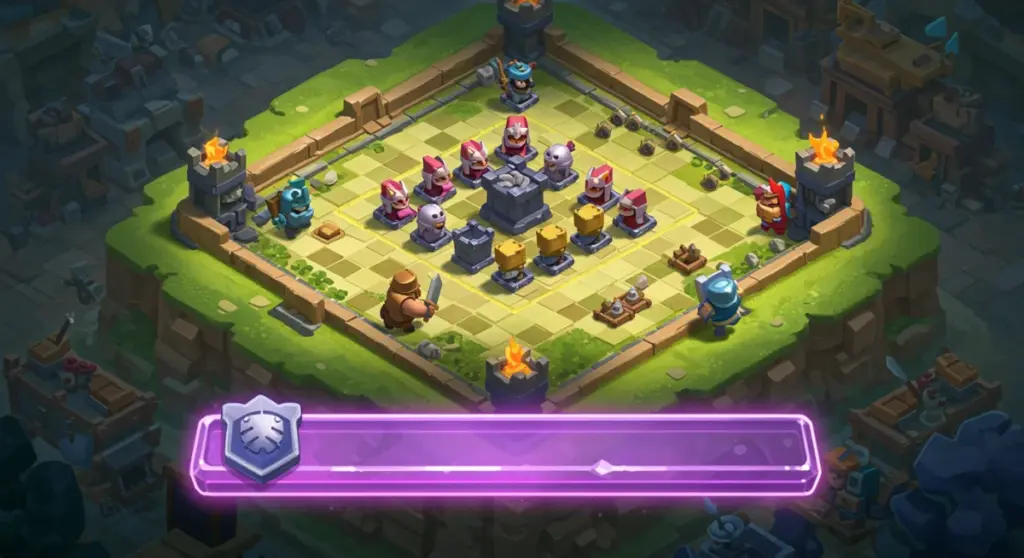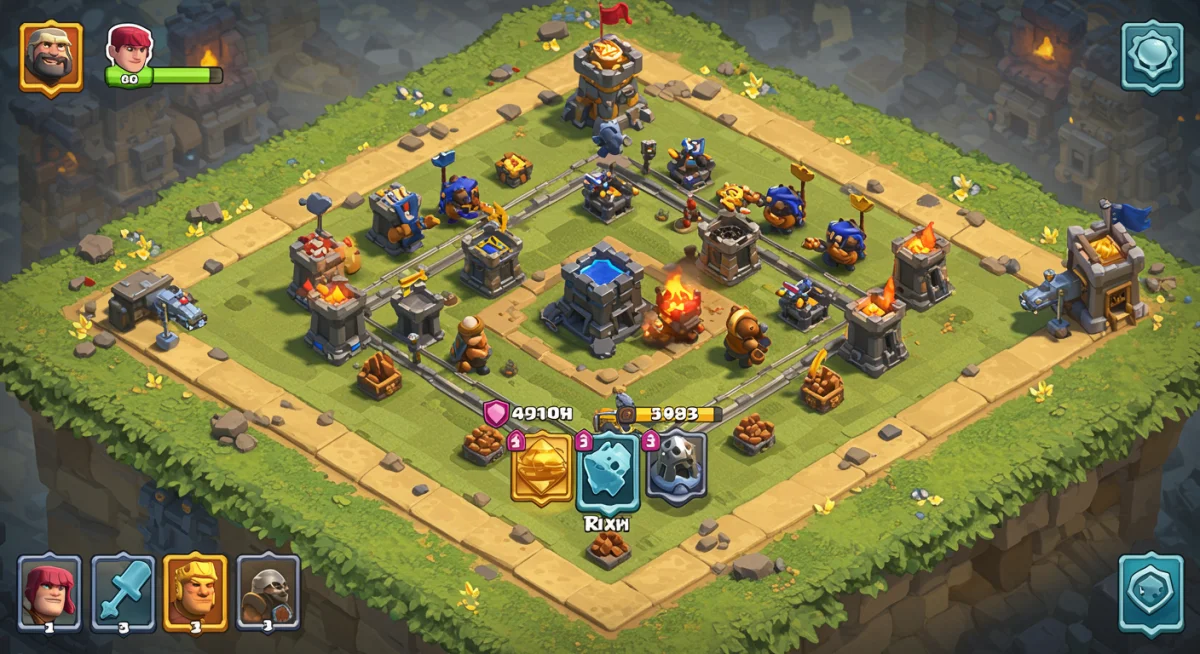Clash Royale Elixir Management: Ultimate Guide

Anúncios
Mastering elixir management in Clash Royale is paramount for consistent victories, allowing players to outmaneuver opponents by optimizing resource deployment, understanding elixir cycles, and making informed strategic decisions throughout every match.
Welcome, fellow Clash Royale enthusiasts! If you’ve ever wondered what separates a good player from a truly great one, the answer often lies in one critical aspect: Clash Royale Elixir Management. This isn’t just about waiting for your elixir bar to fill; it’s about a profound understanding of resource allocation that can turn the tide of any battle.
Understanding the Elixir Economy
The elixir economy is the lifeblood of Clash Royale, dictating the pace and flow of every match. Each card in your deck costs a certain amount of elixir, and your ability to generate, spend, and conserve this resource effectively is the cornerstone of high-level play. Ignoring this fundamental principle is akin to entering a chess match without understanding the value of your pieces.
At its core, elixir generation is constant, ticking up one unit every 2.8 seconds during the first two minutes of a match, and then accelerating to one unit every 1.4 seconds during Double Elixir Time. This seemingly simple mechanic hides a complex layer of strategic depth, as every elixir point spent or wasted contributes to your overall advantage or disadvantage.
Elixir Cycle and Card Rotation
Your deck’s average elixir cost directly impacts your elixir cycle. A lower average cost means you can cycle through your cards faster, often allowing you to play the same powerful cards more frequently than your opponent. Conversely, a high-cost deck requires more careful elixir management and often relies on strong defensive plays to build up a counter-push.
- Low-Cost Decks: Enable rapid cycling, allowing for continuous pressure and quick reactions.
- High-Cost Decks: Require patience and precise defensive plays to generate elixir advantages for big pushes.
- Balanced Decks: Offer a mix of offensive and defensive capabilities, providing flexibility in various match-ups.
Understanding your deck’s cycle speed in relation to your opponent’s is crucial. If you know your opponent has just played their main win condition, you can often push aggressively, knowing they won’t have it available to defend immediately. This foresight comes directly from an awareness of the elixir cycle.
The goal is always to make positive elixir trades, meaning you use less elixir to counter an opponent’s push than they spent to create it. This gradual accumulation of elixir advantage is what allows you to overwhelm your opponent in the later stages of a match.
Positive Elixir Trades: The Foundation of Victory
Achieving positive elixir trades is arguably the most important skill in Clash Royale. It’s the art of spending less elixir than your opponent to defend their attacks or to counter their deployed troops. Each successful positive trade adds to your elixir bank, creating a snowball effect that can lead to an unstoppable push. This concept is not merely about defense; it’s about converting defensive success into offensive power.
Imagine your opponent plays a 6-elixir Golem, and you manage to defend it effectively with a 3-elixir Mini P.E.K.K.A. and a 2-elixir Skeletons. You’ve just gained a 1-elixir advantage, which might seem small, but these small advantages accumulate rapidly over the course of a battle. These micro-decisions are what define superior elixir management.
Common Positive Trade Scenarios
There are numerous ways to achieve positive elixir trades, and recognizing these opportunities is vital for competitive play. Mastering these scenarios will significantly improve your win rate.
- Using Spells Effectively: A well-timed Fireball on a Wizard and Musketeer offers immense elixir value.
- Kiting Troops: Luring high-damage troops with cheap units like Skeletons or Goblins can drastically reduce incoming damage for minimal elixir cost.
- Tower Protection: Allowing your tower to absorb some damage from low-health troops instead of deploying a card saves elixir for future pushes.
- Splash Damage Units: Using cards like the Wizard or Baby Dragon to clear multiple low-health units provides excellent elixir efficiency.
Understanding troop interactions and placement is key to consistent positive trades. Knowing which cards counter others efficiently is fundamental. For instance, using a 3-elixir Knight to absorb damage from a 4-elixir Hog Rider while your tower deals damage is a common and effective positive trade. Always be thinking about the elixir cost versus the value gained from your play.

Elixir Pumping and Denial Strategies
Beyond simply making positive trades, advanced elixir management involves active strategies to generate more elixir or deny your opponent theirs. The Elixir Collector is the most direct way to generate passive elixir, while aggressive plays can often force your opponent to overcommit, indirectly denying them elixir.
Deploying an Elixir Collector strategically can be a game-changer, but it’s a high-risk, high-reward play. A poorly placed collector can be easily destroyed, giving your opponent a significant elixir advantage. Conversely, a well-protected collector can ensure a steady stream of extra elixir, fueling powerful pushes that your opponent simply cannot match.
Maximizing Elixir Collector Value
The Elixir Collector demands careful consideration regarding its placement and timing. It should ideally be placed in the middle of your territory, between your two Princess Towers, to draw fire and protect it from direct spell damage. Timing its deployment is also crucial, often best done when you have a slight elixir lead or after defending a major push.
- Defensive Placement: Position the collector to act as a distraction for enemy troops like Hog Rider or Golem.
- Timing: Deploy when you are at full elixir or have a perceived elixir advantage, ensuring you can defend it.
- Protection: Be prepared to defend your collector, as it becomes a prime target for opponent spells and troops.
Elixir denial is another powerful tactic. This involves continuously pressuring your opponent, forcing them to spend elixir defensively and preventing them from building up their own elixir advantage or deploying their Elixir Collector. Aggressive bridge spam decks often excel at elixir denial, keeping the opponent on the back foot.
Another form of elixir denial comes from predicting your opponent’s plays. If you anticipate they will play a specific high-cost card, you can often make a cheap counter-play that forces them to defend, thereby disrupting their intended elixir flow and strategy. This requires a deep understanding of common deck archetypes and player tendencies.
The Art of Elixir Bait and Punishment
Elixir baiting is a sophisticated strategy involving intentionally deploying low-cost troops to provoke an overreaction from your opponent, forcing them to spend more elixir than necessary. Once they’ve committed their high-cost counter, you can then punish them with your main offensive push, knowing their key defensive cards are out of rotation.
This tactic relies heavily on psychological warfare and a keen understanding of card interactions. For example, playing a Goblin Barrel might bait out an expensive spell like Zap or Log. Once that spell is used, you can then deploy another swarm unit, like Skeleton Army or Minion Horde, knowing it will be much harder for your opponent to deal with.
Effective Baiting Techniques
Successful elixir baiting isn’t about throwing cards aimlessly; it’s about calculated risks and intelligent card sequencing. Knowing which cards your opponent has in hand and how they typically respond to certain threats is paramount.
- Spell Bait: Use swarm units (Goblin Gang, Skeleton Army) to bait out spells (Zap, Log, Arrows).
- Tank Bait: Deploy a mini-tank (Knight, Valkyrie) to draw out high-damage single-target troops (P.E.K.K.A., Mini P.E.K.K.A.).
- Win Condition Bait: Use a secondary win condition to force out their primary defense, opening the way for your main win condition.
Punishment, on the other hand, is about capitalizing on your opponent’s mistakes or overcommitments. If your opponent plays a Golem at the back, you might immediately launch a strong push on the opposite lane, forcing them to split their elixir or lose a tower. This immediate counter-attack prevents them from building up a massive push behind their tank.
Another form of punishment is exploiting an opponent’s low elixir state. If you know they’ve just spent all their elixir on a big push that you successfully defended, that’s your window to launch a counter-attack. They will have limited resources to defend, making your push far more effective. Recognizing these moments of vulnerability is key to converting elixir advantages into tower damage.
Defensive Elixir Management
While offensive plays often grab the spotlight, impeccable defensive elixir management is equally, if not more, important. A strong defense not only protects your towers but also creates opportunities for devastating counter-pushes. Every elixir spent defensively must be justified by the value it provides, ideally leading to a positive elixir trade.
The goal in defense is to use the minimum amount of elixir necessary to neutralize an incoming threat. Over-defending, or using too many cards to counter a small push, can leave you vulnerable to a counter-attack in the other lane or prevent you from building your own offensive presence. It’s a delicate balance of protection and conservation.
Key Defensive Principles
Effective defense involves more than just dropping cards. It requires precise timing, optimal placement, and an understanding of troop interactions to maximize efficiency.
- Optimal Placement: Place defensive troops strategically to pull enemies, activate the King Tower, or maximize splash damage.
- King Tower Activation: Learn how to activate your King Tower using cards like Goblin Gang or Skeletons against a Hog Rider for increased defensive power.
- Damage Prioritization: Focus on eliminating the biggest threats first, even if it means taking some minor tower damage.
- Counter-Push Setup: Place defensive troops in a way that allows them to transition into an offensive role after clearing the threat.
Consider the interaction between your tower and defensive troops. Sometimes, letting your tower take a few hits from a relatively harmless troop, like a single Goblin, is more elixir-efficient than deploying a card to stop it. This allows you to save that elixir for a more significant threat or your own offensive push. Always assess the threat level versus the elixir cost of the counter.

Adapting to Double Elixir and Triple Elixir
The mid-to-late game in Clash Royale introduces Double Elixir and, in some game modes, Triple Elixir. These phases dramatically accelerate elixir generation, fundamentally changing the strategic landscape. What works in single elixir often needs significant adjustment during these high-octane periods.
During Double Elixir, players can deploy troops much faster, leading to larger pushes and more intense defensive exchanges. The pace of the game increases exponentially, and decision-making must be quicker and more precise. The margin for error shrinks considerably, as a single misplay can cost you a tower or even the match.
Strategies for Accelerated Elixir
Adapting your playstyle to the increased elixir flow is crucial for maintaining an advantage. This often involves building larger pushes and being more aggressive with offensive plays.
- Larger Pushes: Combine multiple threats into one massive push that is harder to defend.
- Faster Cycling: Utilize your low-cost cards to cycle more rapidly to your win conditions or key defensive spells.
- Aggressive Offense: Don’t be afraid to launch multiple pushes in succession, overwhelming your opponent’s defenses.
- Spell Value: Spells become even more potent due to the increased density of troops on the field.
Triple Elixir takes this to an even greater extreme, allowing for truly insane combinations and rapid-fire card deployment. In these modes, the player who can manage their elixir best, making the most efficient trades and building the most unstoppable pushes, will almost always emerge victorious. It’s a test of both quick thinking and a deep understanding of your deck’s capabilities under pressure. The key is not just spending elixir, but spending it wisely, even when you have an abundance of it.
Practice and Refinement: Mastering Your Elixir Flow
Theoretical knowledge of elixir management is one thing; putting it into practice consistently is another. Mastering your elixir flow requires countless hours of gameplay, constant self-analysis, and a willingness to learn from every match, win or lose. It’s an ongoing process of refinement that separates the casual player from the true champion.
Don’t be discouraged by losses. Instead, view them as valuable learning opportunities. Replay your matches, analyze your elixir trades, and identify moments where you overspent or under-defended. Understanding your own tendencies and weaknesses is the first step towards improvement. This reflective practice is far more effective than just mindlessly grinding games.
Tips for Improving Elixir Management
To truly refine your elixir management skills, consider adopting these practices into your routine. Consistent effort in these areas will yield significant improvements over time.
- Watch Pro Players: Observe how top players manage their elixir, especially in tight situations. Pay attention to their card placement and timing.
- Experiment with Decks: Play different deck archetypes to understand how elixir management varies with different card costs and strategies.
- Focus on One Skill: In each match, try to focus specifically on making positive elixir trades or baiting out a specific spell.
- Record and Review: Use in-game replay features to analyze your own games, pausing to assess elixir counts and decision points.
Ultimately, elixir management is a journey, not a destination. The meta changes, new cards are introduced, and your opponents evolve. Staying ahead requires continuous adaptation and a deep commitment to understanding the core mechanics of Clash Royale. By consistently practicing and refining your approach to elixir, you will undoubtedly become a more formidable and strategic player, gaining a significant advantage in every battle you undertake.
| Key Aspect | Brief Description |
|---|---|
| Elixir Economy | Understanding elixir generation rates and how deck cost impacts card cycling speed. |
| Positive Trades | Using less elixir to counter an opponent’s push than they spent to create it. |
| Elixir Bait & Punishment | Provoking overreactions from opponents to gain elixir advantage, then capitalizing on their low elixir. |
| Defensive Efficiency | Minimizing elixir spent on defense while maximizing protection and counter-push potential. |
Frequently Asked Questions About Elixir Management
The most common mistake is over-defending, where players spend too much elixir to counter a relatively small or harmless push. This leaves them with a significant elixir disadvantage, making it difficult to launch their own offensive plays or defend subsequent threats effectively. Learning to take minimal tower damage is key.
During the first two minutes of a match, elixir generates at a rate of one unit every 2.8 seconds. This rate doubles during the last minute (Double Elixir Time) to one unit every 1.4 seconds. In some game modes, Triple Elixir Time further accelerates this, making careful management even more critical.
Generally, yes. Low-cost decks inherently cycle faster due to their lower average elixir cost, allowing players to reach their key cards more frequently. However, a skilled player with a high-cost deck can mitigate this by making excellent defensive trades and forcing their opponent to overcommit, thus disrupting the low-cost deck’s cycle.
Elixir banking refers to reaching maximum elixir (10) and then playing a card immediately to start generating elixir again without wasting any. It’s crucial because every second spent at 10 elixir means lost potential elixir, which can translate into a significant disadvantage over time. Efficient banking maximizes your total elixir generated.
Practice by consistently reviewing your replays to identify wasted elixir or poor trades. Focus on one aspect at a time, like spell baiting or efficient defense. Watch professional players to observe their decision-making and experiment with various deck archetypes to understand different elixir dynamics. Consistent, deliberate practice is key.
Conclusion
Mastering elixir management in Clash Royale is not a single skill but a complex interplay of understanding game mechanics, strategic decision-making, and continuous adaptation. From recognizing positive elixir trades to effectively baiting out opponent spells and navigating the accelerated pace of Double Elixir Time, every aspect contributes to your overall success. By diligently practicing these principles and constantly refining your approach to elixir, you will undoubtedly become a more formidable and strategic player, gaining a significant advantage in every battle you undertake.





